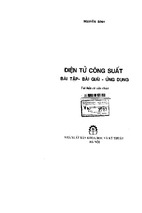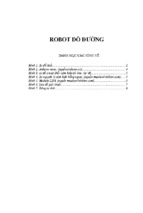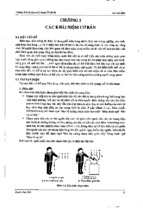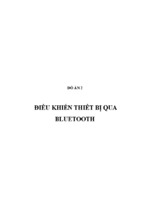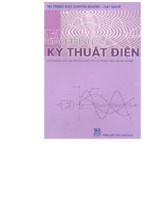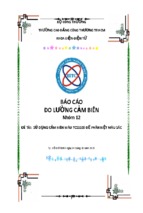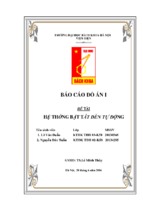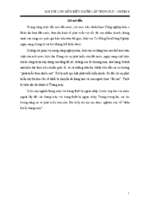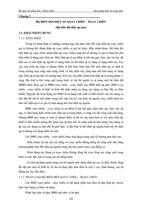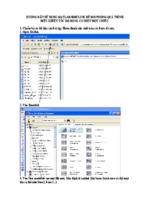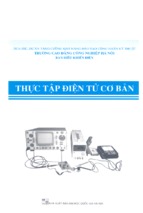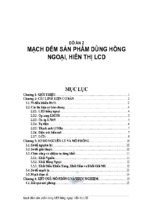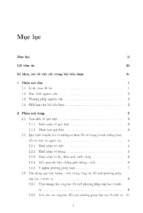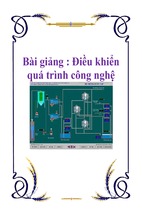Mô tả:
Programming PIC Microcontrollers
Module: EE2A2 Embedded Microprocessor Systems
Lecturer: James Grimbleby
y
URL: http://www.personal.rdg.ac.uk/~stsgrimb/
email: jj.b.grimbleby
g
y reading.ac.uk
g
Number of Lectures: 5
Recommended text book:
R Barnett
R.
Barnett, L O’Cull
O Cull and S
S. Fox
Embedded C Programming and the Microchip PIC
Thomson (2004)
ISBN 1401837484
James Grimbleby
School of Systems Engineering - Electronic Engineering
Slide 1
Programming PIC Microcontrollers
Recommended Text Book:
R. Barnett, L O’Cull
O Cull and S. Fox
Embedded C Programming
and the Microchip
p PIC
Thomson (2004)
ISBN 1401837484
Price (Amazon) £47
James Grimbleby
School of Systems Engineering - Electronic Engineering
Slide 2
Programming PIC Microcontrollers
On-line book describing PIC microcontrollers:
http://www.mikroelektronika.co.yu/english/product/books/
htt
//
ik l kt ik
/
li h/ d t/b k /
PICbook/0_Uvod.htm
James Grimbleby
School of Systems Engineering - Electronic Engineering
Slide 3
Programming PIC Microcontrollers
Manual for CCS PIC
C compiler:
http://www ccsinfo com/downloads/ccs c manual pdf
http://www.ccsinfo.com/downloads/ccs_c_manual.pdf
James Grimbleby
School of Systems Engineering - Electronic Engineering
Slide 4
Programming PIC Microcontrollers
This course is about programming PIC microcontrollers in C
using the CCS PIC-C compiler
Topics covered include:
PIC architecture
PIC specific limitations and extensions to C
PIC-specific
Programming PIC hardware such as ports, ADC, timers, etc
Using software libraries
You should already be familiar with the C and C++
programming languages
James Grimbleby
School of Systems Engineering - Electronic Engineering
Slide 5
Assessment
This unit
nit will
ill be assessed b
by a m
multiple-choice
ltiple choice test
The multiple-choice
multiple choice test will last for 30 minutes
minutes, during which
20 questions must be answered
You will be permitted to bring your notebooks and the course
notes into the test
The test will be held at the end of the Autumn term
The marks from this test will contribute to the overall mark for
the module EE2A2
James Grimbleby
School of Systems Engineering - Electronic Engineering
Slide 6
Multi-Choice
Multi
Choice Test Example
This question relates to the use of the CCS PIC C
compiler.
A variable q is declared:
long int q;
q can take
k on any value
l
in
i the
h range:
(a)
(b)
(c)
(d)
(e)
-128 to +127
0 to 255
2
-32768 to +32767
0 to 65535
-2147483648 to + 2147483647
Answer:
James Grimbleby
School of Systems Engineering - Electronic Engineering
Slide 7
Programming PIC Microcontrollers
Lecture 1
PIC Architecture
James Grimbleby
School of Systems Engineering - Electronic Engineering
Slide 8
PIC Microcontroller Architecture
PICs use Harvard architecture and a RISC instruction set
von Neuman Architecture:
CPU
Program and
P
d
data memory
CPU
Data
memory
Harvard Architecture:
Program
memory
James Grimbleby
School of Systems Engineering - Electronic Engineering
Slide 9
PIC Microcontroller Architecture
Flash
program memory
Program
counter
Instruction
register
Stack
Counter/
ti
timers
RAM
g
file registers
Address MUX
FSR
I/O ports
g
Status register
Instruction
decode
Watchdog
Start up timer
Timing
generation
James Grimbleby
MUX
Brn out reset
ALU
Peripherals
Low volt prog
Debugger
W register
School of Systems Engineering - Electronic Engineering
Slide 10
PIC Microcontroller Peripherals
The 18F452 PIC has the following peripherals:
Data ports A (6
(6-bit)
bit), B (8
(8-bit)
bit), C (8
(8-bit)
bit), D (8
(8-bit)
bit), E (3
(3-bit)
bit)
Timer/counter modules 0 (8-bit), 1 (16-bit), 2 (8-bit), 3 (16-bit)
CCP/PWM modules (2)
I2C/SPI serial
i l portt
USART ((RS-232,, RS-485))
Analogue-to-digital converter (10-bit) with 10 way input
multiplexer
EEPROM (256 byte)
James Grimbleby
School of Systems Engineering - Electronic Engineering
Slide 11
Clock Generator
PICs use a fully static design so that any clock frequency up
to the specified maximum can be used
There are 4 possible clock configurations:
- external clock (eg crystal oscillator module)
- self-oscillating with external crystal or ceramic resonator
- external or self-oscillating with phase-locked loop
- self-oscillating with external RC
In practice the choice will normally be a compromise
between cost and clock speed or clock stability
James Grimbleby
School of Systems Engineering - Electronic Engineering
Slide 12
Reset
A reset p
puts the PIC in a well-defined initial state so that the
processor starts executing code from the first instruction
Resets can result from:
- external reset by MCLR pulled low
- reset on power-up
- reset by watchdog timer overflow
- resett on power supply
l b
brown-outt
Reset can be used
sed as a last resort for reco
recovering
ering from some
catastrophic software event but all current data will be lost
James Grimbleby
School of Systems Engineering - Electronic Engineering
Slide 13
Central Processing Unit
The CPU fetches instructions from memory, decodes
them, and passes them to the ALU for execution
The arithmetic logic unit (ALU) is responsible for adding,
subtracting, shifting and performing logical operations
Th ALU operates iin conjunction
The
j
i with:
ih
- a general-purpose register called the W register
- an f register that can be any location in data memory
- literals
lit l embedded
b dd d in
i the
th iinstruction
t ti code
d
James Grimbleby
School of Systems Engineering - Electronic Engineering
Slide 14
Memory Organisation - Stack
A 31
31-level
level stack stores the return address during interrupts
and subroutine calls
Program Counter 21 bit
Stack level 1
Stack level 2
..
..
..
.
Stack level 31
James Grimbleby
School of Systems Engineering - Electronic Engineering
Slide 15
Memory Organisation - Program
Program memory
contains the Reset and
Interrupt vectors
The PIC18F452 has 32k
(0x8000) locations of
program memory
Reset vector
0x0000
High priority int vector
0x0008
Low priority int vector
0x0018
P
Program
memory
0x7FFF
James Grimbleby
School of Systems Engineering - Electronic Engineering
Slide 16
Memory Organisation - Data
Data memory contains general
purpose registers (GPRs) and
special function registers
(SFRs)
The PIC18F452 has 1536
(0x600) locations of GPR data
memory
GPR bank 0
GPR bank 1
GPR bank 2
GPR bank 3
GPR bank 4
GPR bank 5
Unused
SFRs
James Grimbleby
0x000
0x100
0x200
0x300
0x400
0x500
0x600
School of Systems Engineering - Electronic Engineering
0xF80
0xFFF
Slide 17
Memory Organisation – SFRs
The memory block
0xF80 to 0xFFF (128
locations) references
special function
registers (SFRs)
Some of the SFRs
are shown
h
h
here
James Grimbleby
Port A
Port B
Port C
Port D
Port E
...
..
Tris A
Tris B
Tris C
Tris D
Tris E
0xF80
0
F80
0xF81
0xF82
0xF83
0xF84
0xF92
0xF93
0xF94
0xF95
0xF96
SPBRG
...
..
Timer1L
Timer1H
...
..
Timer0L
Timer0H
...
..
Wreg
...
..
StkPtr
School of Systems Engineering - Electronic Engineering
0 FAF
0xFAF
0xFCE
0xFCF
0xFD6
0xFD7
0xFE8
0xFFC
Slide 18
PIC Instruction Set
The PIC instruction set has a small number of simple (RISC)
instructions
PIC16 series: 35 instructions coded into 14 bits
PIC 18 series: 59 instructions coded into 16 bits
PIC 24 series: 71 instructions coded into 24 bits
Most instructions are executed in one instruction cycle which
corresponds to 4 clock cycles
Thus a PIC operating at 40 MHz clock frequency will have an
instruction rate of 10 MIPS.
James Grimbleby
School of Systems Engineering - Electronic Engineering
Slide 19
PIC 18Fxxx Instruction Set
Most PIC 18Fxxx instructions occupy a single 16-bit program
memory location
Each instruction consists of an opcode and one or more
operands
The instruction set is highly orthogonal and can be
partitioned:
- 31 byte-oriented file register operations
- 5 bit-oriented file register operations
- 23 control instructions
- 10 literal instructions
- 8 data memory – program memory operations
James Grimbleby
School of Systems Engineering - Electronic Engineering
Slide 20
- Xem thêm -

